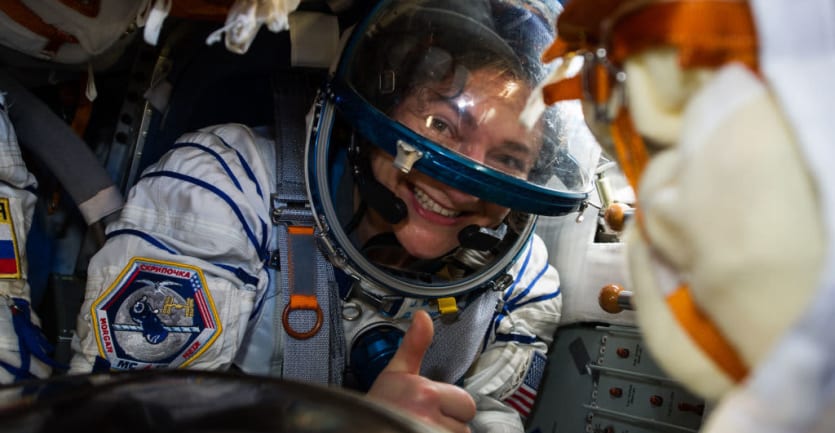How to Become an Astronaut
- In addition to overseeing space missions, astronauts clean and maintain space stations.
- Aspiring astronauts need to have a master’s degree, usually in a STEM field.
- You must also complete two years of training and pass the notoriously hard NASA physical.
- Those interested in space can find jobs as scientists, engineers, or astronomers.
When Neil Armstrong stepped on the moon in 1969, kids across the U.S. had stars in their eyes, dreaming of a career that had never before existed: They wanted to become astronauts.
A lot has changed in the past 50 years. Even though a career as a YouTube star has surpassed astronauts in popularity, many kids still want to explore space.
Of course, becoming an astronaut isn’t easy. For this career path, you really only have one potential place of employment: the National Aeronautics and Space Administration, more commonly known as NASA.
NASA doesn’t maintain a massive workforce when it comes to astronauts. Currently, 48 active astronauts are employed by NASA, and fewer than 600 people have gone into space in the past 50 years. But if you’ve got the dream and enough determination, you just might stand a chance at joining the ranks of these real-life adventurers.

What Does an Astronaut Do?
Despite what you’ve seen from Buzz Lightyear in “Toy Story,” astronauts don’t fly through space shouting, “To infinity and beyond!” — they have real tasks, just like the rest of us.
Astronauts fulfill different roles when carrying out space missions, such as commander and pilot.
Astronauts fulfill different roles when carrying out space missions. The commander is the person in charge who ultimately makes the most important decisions on a space mission. The pilot works closely alongside the commander. Other astronauts take on the role of mission specialist, in which they utilize special skills or a specific area of knowledge.
Astronauts also perform many mundane tasks to keep space stations running. The crew cleans and checks equipment and repairs things that have broken. They spend two hours every day exercising, too, in order to keep up with the physical demands of the job.
How to Become an Astronaut
There’s no “astronaut” major in college. The people NASA chooses to become astronauts aren’t necessarily those who have dedicated their lives to becoming space explorers. Instead, they’re experts in math and science who meet all of NASA’s qualifications.
Aspiring astronauts must have a master’s degree in addition to at least two years of relevant professional experience. Alternatively, they may complete at least 1,000 hours of pilot-in-command time on a jet aircraft.
In addition to meeting all physical requirements, aspiring astronauts must have a master’s degree and at least two years of relevant work experience.
Then comes the hard part. Astronauts must pass the NASA long-duration flight astronaut physical. If you’re under 5 feet, 2 inches, or over 6 feet, 3 inches, you’re out of luck. Candidates need 20/20 vision, though they may use corrective lenses. Their blood pressure also cannot exceed 140/90 when sitting down.
When it comes to applying for the job, astronaut Anne McClain offers some surprisingly normal advice: Work on your resume. Make sure it’s concise and free of errors. NASA wants to know that its astronauts pay attention to small details, a critical skill needed for scientists.
How Hard Is It to Become an Astronaut?
NASA hires new astronauts every four years or so, and quite a few people apply. In 2013, 6,000 people applied to become astronauts; NASA selected eight. And when a whopping 18,300 people applied for the class of 2017, only 12 were accepted — that’s an acceptance rate of less than 1%.
Only 12 out of 18,300 astronaut applicants were accepted for NASA’s class of 2017 — that’s an acceptance rate of less than 1%.
The road to becoming an astronaut is not easy. Even if NASA approves your application, it’ll take some time before you actually leave Earth.
First, you need to complete two years of basic training. That includes both physical training and classroom studying. Astronaut trainees study Russian so they’ll be able to communicate with the Russian Mission Control Center, and learn about both spaceships and the science involved in space stations.
Astronauts-in-training must also pass physical tests. They need to earn scuba certification and swim three laps in a pool while wearing a flight suit. They must undergo military land and water survival training, too, which is essential for emergencies.
Finally, trainees must practice in simulations that allow them to get used to high and low atmospheric pressures.
How Much Schooling Do You Need to Become an Astronaut?
Applicants must possess both a bachelor’s degree and a master’s degree in a relevant STEM field, such as engineering, biology, physical science, computer science, or math. NASA also considers astronauts who are at least two years into a doctoral program, who have a medical doctoral degree, or who have completed a test pilot school program.
All in all, astronauts usually spend at least six years in postsecondary schooling — sometimes more if they have a doctorate.
How Long Does It Take to Become an Astronaut?
On top of the six years of schooling and two years of professional experience, astronauts must complete two years of mandatory basic training. All of this adds up to about a decade of preparation.
After that, astronauts may need to wait months or years before they can even embark on their first space mission. Before leaving Earth, astronauts must finish advanced mission training, which further equips them for space exploration.
Alternative Careers in Space Exploration
Maybe you want to join NASA, but going to space doesn’t really appeal to you. Or maybe the fierce competition for becoming an astronaut feels like too much pressure. The good news is that you can still work in space travel without ever departing Earth.
NASA, research institutions, and universities all hire professionals for various jobs to make sure we get the most out of space exploration. In 2019, over 66,000 people worked as aerospace engineers, according to the Bureau of Labor Statistics. These individuals design and create spacecraft, as well as aircraft and missiles for national defense purposes.
Atmospheric scientists also work in the space realm by studying atmospheric phenomena and climates using satellites and radar systems. About 10,000 individuals were employed as atmospheric scientists in 2019.
Those who want to work in space without becoming an astronaut can pursue careers in aerospace engineering, atmospheric science, or astronomy.
Astronomy is another popular route, with 20,500 people currently working as astronomers. If you’re fascinated by science and want to study concepts like galaxies, planetary formation, stellar evolution, and dark matter theory, astronomy is an excellent field to consider entering.
You might also look into space-related career options like plasma physicist, computer hardware engineer, electronics engineer, avionics technician, and meteorological technician.
Becoming an astronaut is hard work and isn’t for everyone, but if you’ve got your heart set on space exploration, don’t let the challenges of preparing for the job hold you back.
Explore More College Resources

Summer Semester: When Does It Start? And Should You Enroll?
School’s out — or, rather, in — for summer. Discover the pros and cons of enrolling in an optional summer semester in college.

by Anne Dennon
Updated March 20, 2023



